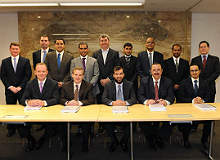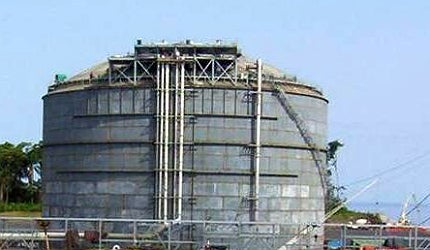
Barzan Gas Project is a $10.4bn project developed by a joint venture (JV) of Qatar Gas and ExxonMobil. The JV appointed RasGas as the project manager. RasGas is also responsible for operating the plant now it is complete.
The Joint Venture Agreement (JVA) and Development and Fiscal Agreement (DFA) by the two JV partners to implement the project was signed in January 2011. The two companies had earlier signed an agreement to participate in the project in 2007.
The project accommodates a total of six trains, with two trains being developed in the first phase. The first train is scheduled to come online in 2014 and the second train in 2015.
Construction works for the Barzan Gas Project started in November 2011 and 50% of the work was completed as of December 2012.
The project, which includes both onshore and offshore developments, produced 1.7 billion cubic feet a day (bcfpd) of pure natural gas in the first phase. The completion of first phase increased the total gas output of RasGas to 11bcfpd.
The massive gas project in Qatar currently employs up to 20,000 people in the construction works. The project site covers about three square kilometres.
Barzan Gas Project location
The Barzan LNG plant is located in the North Field at a green-field site in Ras Laffan Industrial City, about 80km north-east of the city of Doha.
The plant provides natural gas to complement the current and future infrastructural developments, such as power plants, desalination plants, New Doha Airport and New Doha Seaport, as the country prepares itself to host the FIFA World Cup in 2022.
The project is also one of the major components in the Qatar National Vision 2030, which intends to make Qatar a developed country by 2030.
Details of Qatar’s gas project development
The Barzan Gas Project was developed in three phases, with a total capacity of 6.2bcf/d of natural gas. The first phase had a capacity of 1.7bcf/d of natural gas, while phases two and three had a capacity of 2bcf/d and 2.5bcf/d of natural gas respectively.
Onshore facilities at the project site comprise of a gas processing unit, a sulphur recovery unit to remove impurities from the natural gas and a natural gas liquids (NGL) recovery unit, which produces methane, ethane, propane, butane and condensate. Ethane produced from the plant is used as a feedstock for petrochemical industries around the project site.
The offshore site is equipped with three offshore wellhead platforms, subsea pipelines extending up to 300km and subsea cables, extending 100km. A platform wellhead was fabricated at Hyundai Heavy Industries’ (HHI) site at Ulsan, Korea and pipelines were layed at the project site in Qatar. The offshore facilities are scheduled for completion by 2013.
Financing the joint venture project
The project achieved financial closure in December 2011. It was financed 30% through equity and 70% through a syndicated loan from banks and credit export agencies.
The deal involved a $3.34bn commercial bank facility, with Skadden, Arps, Slate, Meagher & Florm LLP as the counsel, an $850m Islamic facility and $2.55bn financing by export credit agency (ECA). The ECA financing was arranged by banks and guarantees from Japan, Korea and Italy, with Allen & Overy as the counsel.
Royal Bank of Scotland was the financial advisor. The legal advisor to the sponsors was White & Case.
Contractors involved with Qatar’s Barzan development
The Front-End Engineering Design (FEED) and execution planning contract for the project was awarded to Chiyoda Corporation.
Access, painting and thermal insulation services for the project were carried out by Cape from 2013 through 2014. The contract awarded to Cape was worth $25m. Consultancy services for the project are being provided by Air energi.
The engineering, procurement and construction (EPC) contract for developments onshore was awarded to the Japan Gas Company (JGC). The offshore developments and pipeline installation works were carried out by HHI. The contract for developing the offshore facilities was worth $900m.
Related content
Dolphin Gas Project, Ras Laffan, Qatar
The Dolphin Gas Project is one of the largest trans-border energy projects ever undertaken in the Middle East.
Pearl Gas-to-Liquids Project, Ras Laffan, Qatar
Following the successful opening of the first phase of the Oryx gas-to-liquids facility in June 2006, Qatar Petroleum launched its new GTL project ‘Pearl’ in July 2006.




